Timeline: The Early Renaissance
르네상스는 "부활"을 의미하며 르네상스 미술의 주제는 고대그리스로마신화, 종교화, 그리고 초상화와 작가의 개성이 담겨있는 상상력을 바탕으로 한 다양한 주제들이 보여진다,
Among the Florentine artists of the second half of the fifteenth century who strove for a solution to this question was the painter Sandro Botticelli (1446-1510). One of his most famous pictures represents not a Christian legend but a classical myth - the birth of Venus.
Original name ALESSANDRO DI MARIANO FILIPEPI (b. 1445, Florence [Italy]--d. May 17, 1510, Florence), Florentine early Renaissance painter whose Birth of Venus (c. 1485) and Primavera (1477-78) are often said to epitomize for modern viewers the spirit of the Renaissance. His ecclesiastical commissions included work for all the major churches of Florence and for the Sistine Chapel in Rome. His name is derived from his elder brother Giovanni, a pawnbroker, who was called Il Botticello ("The Little Barrel").
Although he was one of the most individual painters of the Italian Renaissance, Sandro Botticelli remained little known for centuries after his death. Then his work was rediscovered late in the 19th century by a group of artists in England known as the Pre-Raphaelites.
Born Alessandro di Mariano Filipepi in Florence in 1445, Botticelli was apprenticed to a goldsmith. Later he was a pupil of the painter Fra Filippo Lippi. He spent all his life in Florence except for a visit to Rome in 1481-82. There he painted wall frescoes in the Sistine Chapel of the Vatican.
In Florence, Botticelli was a protege of several members of the powerful Medici family. He painted portraits of the family and many religious pictures, including the famous The Adoration of the Magi. The most original of his paintings are those illustrating Greek and Roman legends. The best known are the two large panels Primavera and The Birth of Venus.
###
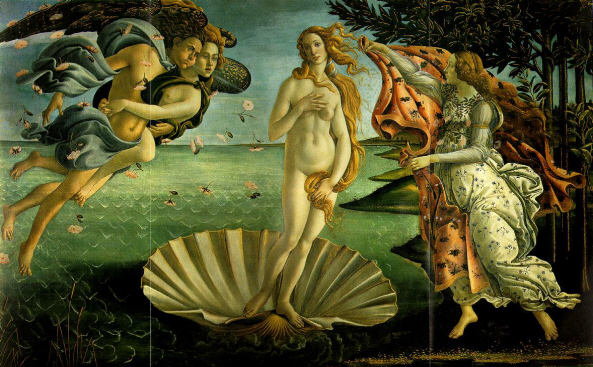
The Birth of Venus
c. 1485-86; painted for the villa of Lorenzo di Pierfrancesco de' Medici at Castello; Tempera on canvas, 172.5 x 278.5 cm; now in the Galleria degli Uffizi in Florence
메디치 가문의 로렌초 디 피에르 프란체스코가 자신의 결혼을 기념하여 주문 제작.
왼편은 독수리 날개를 한 바람(서풍)의 신 제피로스와 꽃의 요정 클로리스 오른편은 과실나무의 요정 포포나. 조개껍질에 탄 사랑과 아름다움의 신 비너스= 아프로디테는 바람에 실려 성스러운 키프로스 섬( 비너스의 탄생지로 전해지는 지중해 동부 파포스의 해변) 에 도착. 비너스의 탄생을 축복하는 꽃잎이 흩날리고 있는 모습. 비너스의 실제 모델은 피렌체의 가장 아름다운 여인 "시모네다 베스 풋"
The classical poets had been known all through the Middle Ages, but only at the time of the Renaissance, when the Italians tried so passionately to recapture the former glory of Rome, did the classical myths become popular among educated laymen. To these men, the mythology of the admired Greeks and Romans represented something more than gay and pretty fairy-tales. They were so convinced of the superior wisdom of the ancients that they believed these classical legends must contain some profound and mysterious truth. The patron who commissioned the Botticelli painting for his country villa was a member of the rich and powerful family of the Medici. Either he himself, or one of his learned friends, probably explained to the painter what was known of the way the ancients had represented Venus rising from the sea. To these scholars the story of her birth was the symbol of mystery through which the divine message of beauty came into the world. One can imagine that the painter set to work reverently to represent this myth in a worthy manner. The action of the picture is quickly understood. Venus has emerged from the sea on a shell which is driven to the shore by flying wind-gods amidst a shower of roses. As she is about to step on to the land, one of the Hours or Nymphs receives her with a purple cloak. Botticelli has succeeded where Pollaiuolo failed. His picture forms, in fact, a perfectly harmonious pattern. But Pollaiuolo might have said that Botticelli had done so by sacrificing some of the achievements he had tried so hard to preserve. Botticelli's figures look less solid. They are not so correctly drawn as Pollaiuolo or Masaccio's. The graceful movements and melodious lines of his composition recall the Gothic tradition of Ghiberti and Fra Angelico, perhaps even the art of the fourteenth century - works such as Simone Martini's Annunciation.
Botticelli's Venus is so beautiful that we do not notice the unnatural length of her neck, the steep fall of her shoulders and the queer way her left arm is hinged to the body. Or, rather, we should say that these liberties which Botticelli took with nature in order to achieve a graceful outline add to the beauty and harmony of the design because they enhance the impression of an infinitely tender and delicate being, wafted to our shores as a gift from Heaven.
This secular work was painted onto canvas, which was a less expensive painting surface than the wooden panels used in church and court pictures. A wooden surface would certainly be impractical for a work on such a scale. Canvas is known to have been the preferred material for the painting of non-religious and pagan subjects that were sometimes commissioned to decorate country villas in 15th-century Italy.
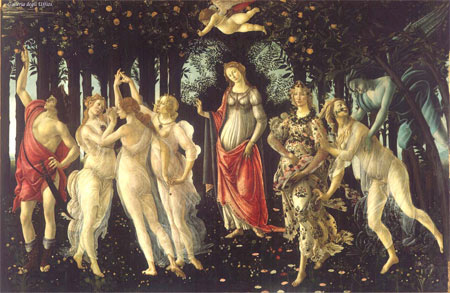
The masterworks Primavera (c. 1478) and The Birth of Venus (c. 1485) were both seen by Vasari at the villa of Lorenzo di Pierfrancesco de' Medici at Castello in the mid-16th century, and until recently it was assumed that both works were painted specifically for the villa. Recent scholarship suggests otherwise: the Primavera was painted for Lorenzo's townhouse in Florence, and The Birth of Venus was commissioned by someone else for a different site. By 1499 both had been installed at Castello.[2]
In these works the influence of Gothic realism is tempered by Botticelli's study of the antique. But if the painterly means may be understood, the subjects themselves remain fascinating for their ambiguity. The complex meanings of these paintings continue to receive scholarly attention, mainly focusing on the poetry and philosophy of humanists who were the artist's contemporaries. The works do not illustrate particular texts; rather, each relies upon several texts for its significance. Of their beauty, characterized by Vasari as exemplifying "grace", and by John Ruskin as possessing linear rhythm, there can be no doubt.
###
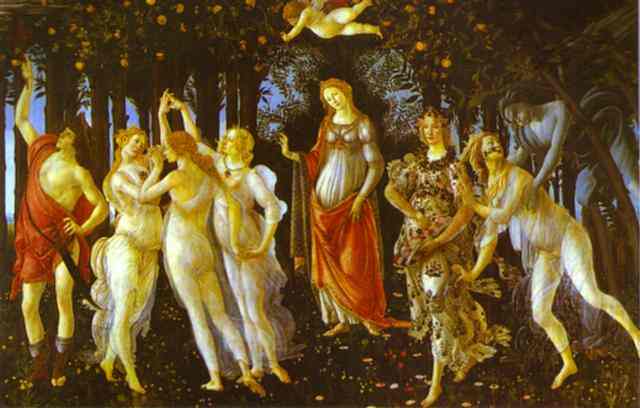
프리마베라 - 봄
La Primavera
1477-78; "Allegory of Spring"; 315 x 205 cm; painted for the villa of Lorenzo di Pierfrancesco de' Medici at Castello
now in the Galleria degli Uffizi in Florence
정신적 사랑(삼미신)과 육체적 사랑(클로리스로 유혹하는 제피로스)을 동시에 보여주고 있다.
그림의 오른쪽에서 부터 서풍, 님프 클로리스(Chloris),
꽃과 봄의 여신 플로라(Flora), 가운데 미의 여신 비너스(Vinus),춤을 추고 있는 세명의 카리테스(charites), 비너스의 머리위에 눈을 가리고 사랑의 화살을 쏘고 있는 비너스의 아들 큐피드(Cupid), 마지막으로 봄의 제전을 악으로 부터 보호하며 봄의 개화를 알려주는 쥬피터의 아들 신의 전령 머큐리(Mercury)가 이그림의 주요 인물로 그려집니다.
그들의 머리위에는 신화 속에서 비너스가 탄생할 때 축하의 의미로 나무에 열린 황금열매가 표현되어 있습니다.
클로리스(Chloris)
연두색,연한 녹색,신선함,푸릇한 새싹등을 뜻한다고 합니다.
로마신화에서 그녀는 봄의 여신 플로라가 되기 전의 님프로 표현됩니다.
한가득 입김을 머금은 서풍의 신 제피로스에 의해 그녀는 봄을 다스리는 전능을 얻게 됩니다. 그녀는 사실 페보니우스에게 납치되어 그와 결혼을 했는데요. 그들 사이에서 과일을 뜻하는 카포스(Karpos)입니다. 그녀가 말을 하면 그녀의 입김은 데이지와, 달맞이꽃,콘플라워등 봄에 피는 아름다운 꽃들로 뒤바뀝니다.
플로라(Flora)
클로리스의 옆에 표현되어 있는 플로라는 클로리스가 꽃의 여신으로 변신하는 과정을 나타낸 것입니다. 자상하게 미소를 짖고 있는 그녀는 온갖 아름다운꽃봉우리로 단장된 드레스를 입고있습니다. 그녀를 납치하여 결혼한 제피로스 뒷날 그의 행동을 후회하고 그녀를 봄의 여신으로 만들어 주고 그녀가 항상 아름답게 가꿀수 있는 정원을 선물합니다. 가운데 다른인물들 보다 조금 물러서서 중심을 잡고 있는 비너스는 봄의 영광과 정신적인 쾌락을 약속하며조용히 미소짖고 있고 그녀의 위에는 어린아이의 모습으로 나타난 큐피드가 눈을 가 리고 아무나 맞힐세라 사랑의 화살을 조준하고 있네요.
카리테스(CHARITES)
미와 사랑의 여신 비너스를 모시는 세명의 그레이스(Three Graces) 카리테스(CHARITES)는 따사로운 봄을 맞이하며 정성을 다해 춤을 춥니다. 그녀들은 세명의 자매로써 첫째 달리아는 좋은 원기,만찬,축제(Good Cheer, Festivities), 둘째 유프라서니(Euphrosyne)는 기쁨과 행복의 웃음을(Mirth,joyful life), 막내 아글라에아는 아름다움(beauty,splendor, brilliant, shining on-e)을 상징합니다. 마지막 왼쪽에 자리잡은 신들의 메신저 머큐리의 존재는 여성이 주가 된 그림의 구도를 오른쪽의 남성이미지의 제피로스와 함께 대칭을 이룸으로써 균형을 줍니다. 머큐리와 날개달린 신발과 더불어 그를 상징하는 지팡이 커두시우스 그는 모든 악이 자리 잡지 못하도록 그의 지팡이 커두시우스(caduceus-두 마리의 뱀이 감긴 꼭대기에 두 날개가 있는 지팡이;평화, 의술의 상징;미육군 의무대의 휘장)를 하늘높이 치켜들고 봄의 입구를 신의 길을 지키고 있다.
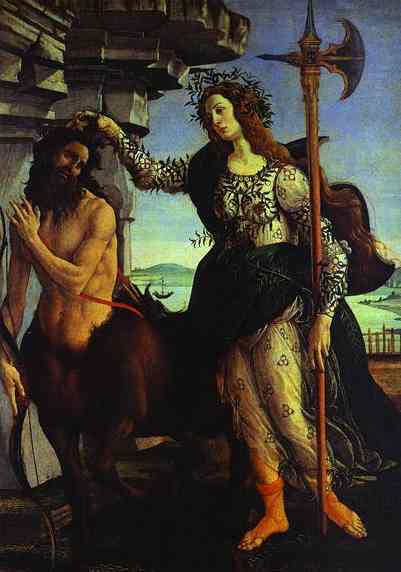
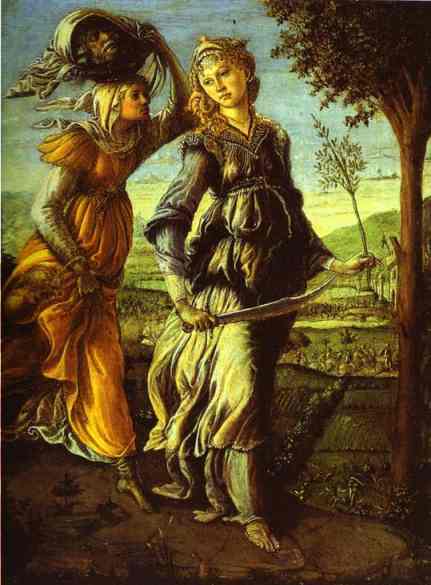

Venus and Mars. 1483. Tempera on panel. National Gallery, London, UK
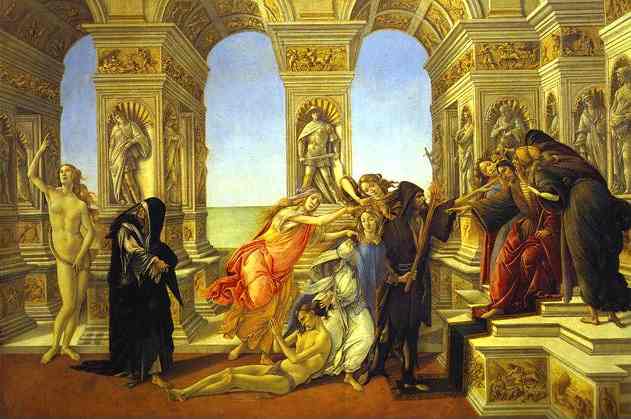
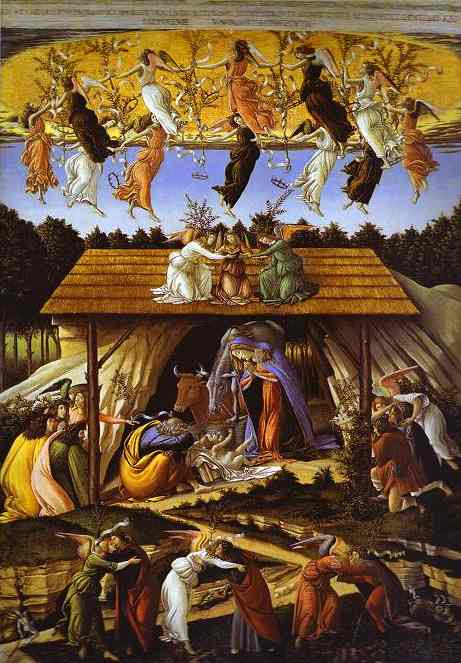
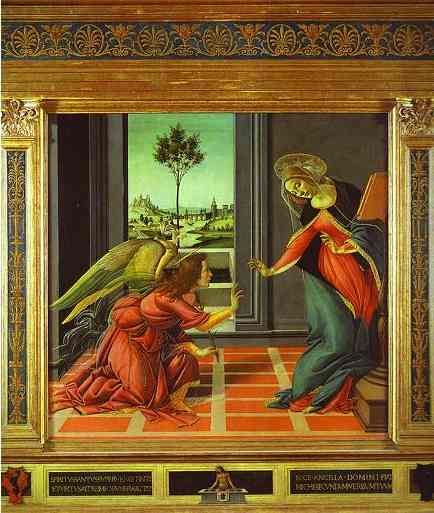
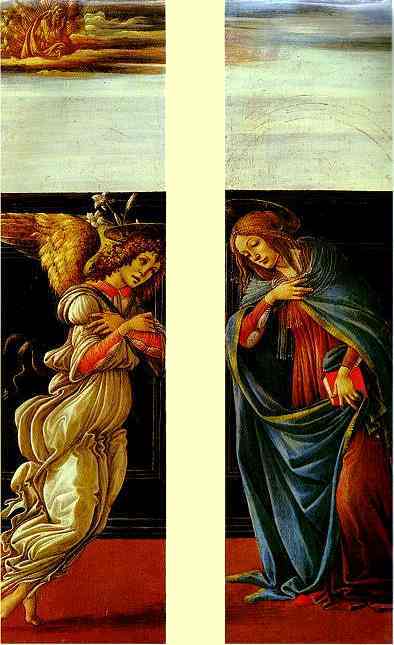
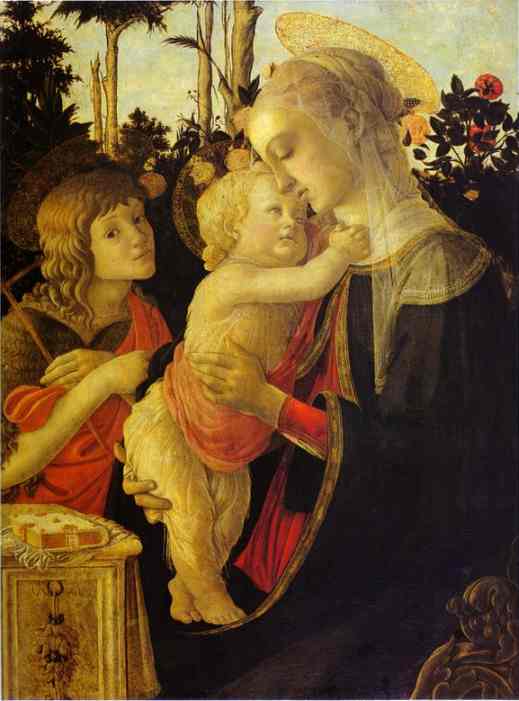
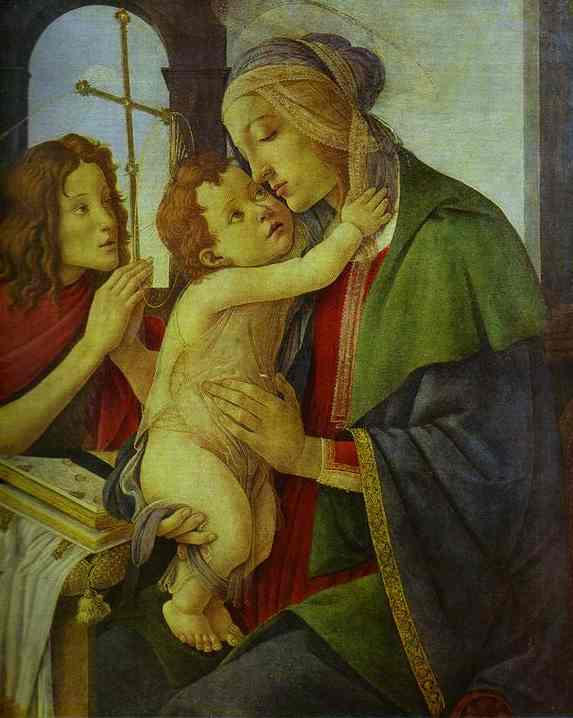
The Virgin and Child with the Infant St. John. After 1500. Tempera on panel. Dresden Gallery, Dresden, Germany.
###

###
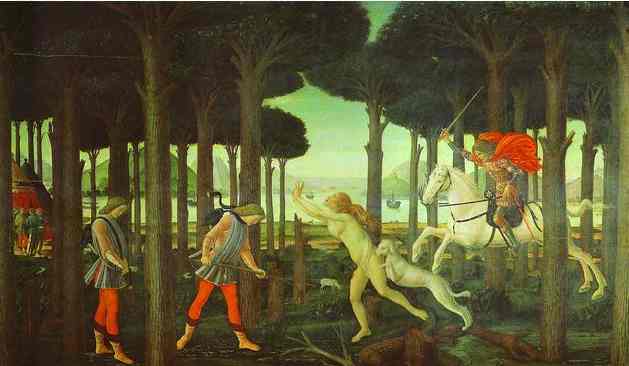
###
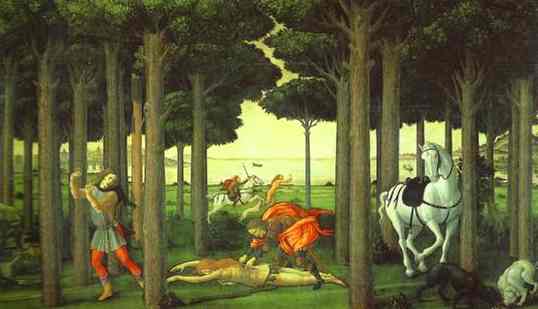
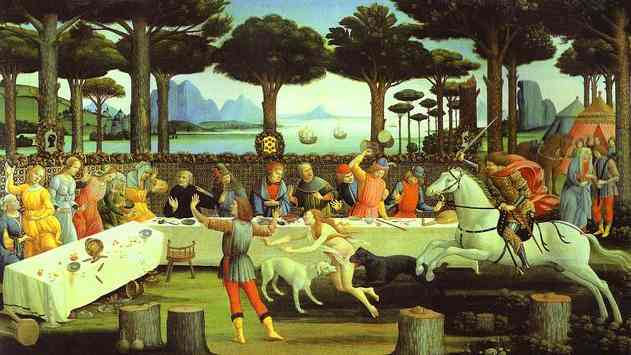
The Banquet in the Pine Forest. 1482-1483. Tempera on panel. Museo del Prado, Madrid, Spain.
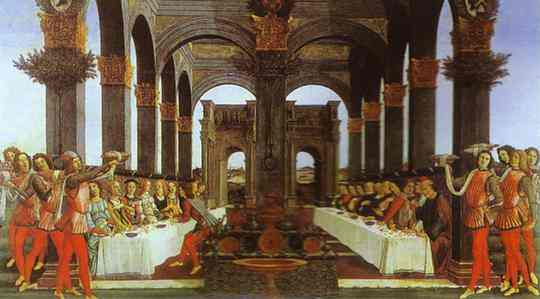
Paolo Uccello. The Hunt in the Forest. c. 1465-70. Oil on canvas. Ashmolean Museum, Oxford, UK. 숲속의 사냥 은 우첼로의 작품으로 보티첼리와 같은 동시대 작가로 비교해 볼 만한 작품이다.
'History of Arts > Renaissance' 카테고리의 다른 글
| 르네상스 초기-얀 반 아이크 (0) | 2020.05.11 |
|---|---|
| 르네상스전성기: Leonardo DA VINCI (0) | 2020.05.11 |
| 르네상스전성기: Michelangelo di Lodovico Buonarroti Simoni (2) | 2020.05.11 |
| 모나리자 르네상스 전성기 (0) | 2020.05.11 |
| 르네상스 건축 (0) | 2007.06.28 |



